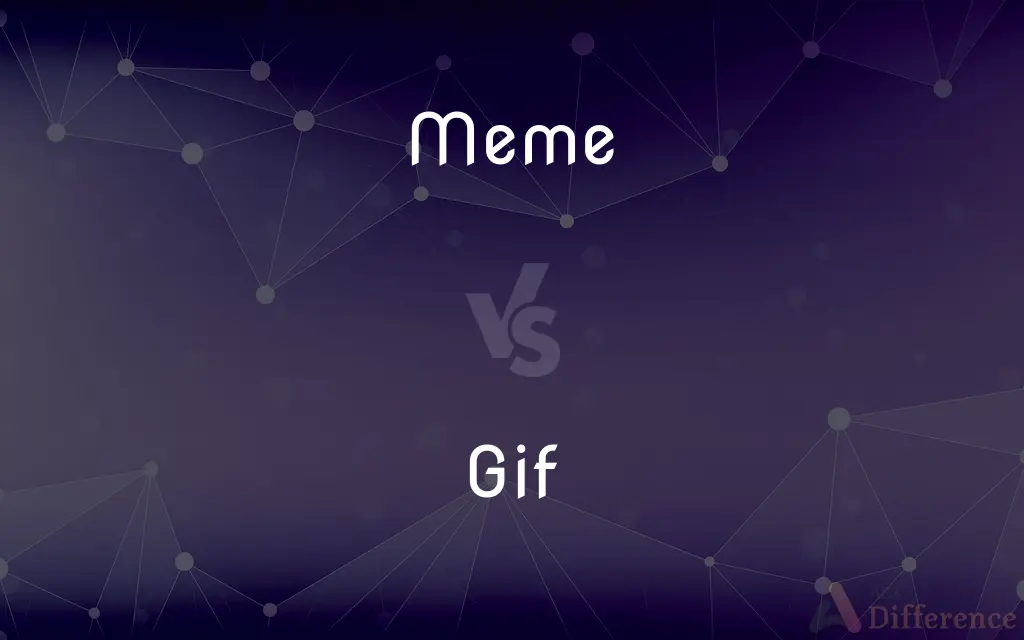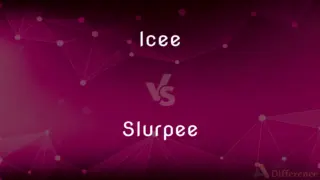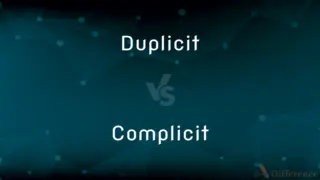Meme vs. Gif — What's the Difference?
By Tayyaba Rehman — Updated on October 9, 2023
Meme is an image/video textually modified to convey culturally relevant humor. Gif is a format for image files that can create short, looping animations. Memes communicate relatable ideas humorously, while GIFs display motion without sound.

Difference Between Meme and Gif
Table of Contents
ADVERTISEMENT
Key Differences
A meme, often a static image paired with expressive text, acts as a communicative vehicle for humor, satire, and culturally pertinent ideologies, typically facilitating shared laughs or insights within a community. In contrast, a GIF (Graphics Interchange Format) serves to visually portray short, silent, and looping animations or snippets, often excerpted from videos or customarily crafted, enabling dynamic visual sharing across digital platforms.
While memes predominantly rely on a cultural context, humor, or shared experiences to evoke emotions or insights, perpetuating relatable scenarios or feelings in a digestible, shareable format, GIFs primarily convey motion, allowing users to share short, silent animations that can express emotions, reactions, or snippets of longer visual media in a concise format.
Interestingly, memes can encapsulate GIFs within their format, marrying text with moving images to compound their expressive capabilities, intertwining visual motion with contextual commentary or humor. Conversely, GIFs, often residing in a silent, looping world, can manifest independently, yet can also morph into memes when imbued with culturally resonant text or contexts.
Memes, often mutated through various iterations to uphold relevance or explore varied comedic avenues, perpetually evolve, often being reshaped by different internet subcultures or communities. Meanwhile, GIFs, once created, generally retain their original form, cyclically presenting the same short visual sequence, yet find varied applications in digital conversations, reactions, or embellishing digital content.
Within a context of utilitarian differentiation, memes extensively navigate through cultural, political, and social dialogues, often embodying a larger cultural commentary or sparking light-hearted communal interactions online. GIFs, with their silent, animated visuals, find prolific usage in digital communications, providing a means to visually articulate emotions, responses, or contexts without necessitating textual or verbal communication.
ADVERTISEMENT
Comparison Chart
Basic Definition
Cultural or humorous expression
Silent, short, looping animation
Format
Can be image, video, or GIF
Strictly an image file format
Text Inclusion
Often includes text
Typically does not include text
Cultural Impact
Engages in cultural commentary
Primarily expressive without commentary
Use Case
Shared for humor or relatability
Utilized for reactions in conversation
Compare with Definitions
Meme
Memes often circulate internet communities.
The popular meme was shared in numerous forums.
Gif
A GIF contains looping visual content.
The GIF of the dancing cat became popular online.
Meme
A meme uses relatable imagery for humor.
The meme made fun of common workplace issues.
Gif
GIFs often serve as digital communication tools.
She sent a GIF to express her excitement without words.
Meme
An image, video, piece of text, etc., typically humorous in nature, that is copied and spread rapidly by Internet users, often with slight variations.
Gif
GIFs can be static or animated.
The animated GIF added a fun element to the webpage.
Meme
A meme reflects shared cultural nuances.
The meme, referencing a TV show, was understood by fans.
Gif
A GIF employs no sound.
The GIF silently looped the memorable movie scene.
Meme
A meme can morph as it circulates.
The meme evolved, taking on different humorous contexts.
Gif
GIFs can be extracted from videos.
The funny moment was captured in a GIF and shared widely.
Meme
A meme ( MEEM) is an idea, behavior, or style that spreads by means of imitation from person to person within a culture and often carries symbolic meaning representing a particular phenomenon or theme. A meme acts as a unit for carrying cultural ideas, symbols, or practices, that can be transmitted from one mind to another through writing, speech, gestures, rituals, or other imitable phenomena with a mimicked theme.
Gif
A lossless format for image files that supports both animated and static images
A GIF image
Meme
An element of a culture or system of behaviour passed from one individual to another by imitation or other non-genetic means.
Gif
A raster-based format for storing files of color graphics.
Meme
A unit of cultural information, such as a cultural practice or idea, that is transmitted verbally or by repeated action from one mind to another.
Gif
An image or animated clip recorded in such a format.
Meme
An image or short video clip, often accompanied by a humorous saying or popular catchphrase, that is transmitted virally, especially on social media.
Gif
Alternative case form of GIF
Meme
A humorous saying or popular catchphrase that is transmitted virally, especially as a caption for such an image or video clip.
Gif
Alternative case form of GIF
Meme
(originally) Any unit of (originally cultural) information, such as a practice or idea, that is transmitted verbally or by repeated action from one mind to another in a comparable way to the transmission of genes.
Gif
If.
Meme
(Internet) Media, usually humorous, which is copied and circulated online with slight adaptations, such as basic pictures, video templates, etc.
Gif
The Graphics Interchange Format, one of the most popular standardized formats for storing graphic data in binary computer files. The standard has been revised several times, and includes provisions for interlacing and animating images. Its disadvantage is that it can store only 256 colors. Compare JPEG.
Meme
(Internet) A specific instance of a meme, such as an image macro or a video, often with humorous superimposed text.
This meme generator lets you make your own memes by adding a caption to existing images, or by uploading your own image.
I'm always posting memes on the groupchat.
Gif
An image stored in GIF{1} format, or the file in which the image is stored; as, he sent three GIF's with lovely pictures of his children.
Meme
Something not to be taken seriously; a joke.
It's a meme degree, you know. Good luck getting a job from that.
Jogging is a meme.
Meme
Granny; nana
Meme
To create and use humorous memes.
Meme
To turn into a meme; to use a meme, especially to achieve a goal in real life.
To meme into existence
Meme
To joke around.
Meme
A cultural unit (an idea or value or pattern of behavior) that is passed from one generation to another by nongenetic means (as by imitation);
Memes are the cultrual counterpart of genes
Meme
Memes may utilize various multimedia formats.
The meme combined a classic painting with modern slang.
Common Curiosities
What characterizes a meme?
Memes combine imagery and text to convey culturally relevant humor or concepts.
Can memes contain various formats?
Yes, memes can utilize images, videos, and GIFs paired with text.
How do GIFs enhance digital communication?
GIFs provide a visual, often entertaining way to express emotions or reactions silently.
Can a GIF be a meme?
Yes, when a GIF with cultural or humorous text is shared widely, it becomes a meme.
What is a GIF’s primary feature?
GIFs are short, silent, looping animations or images.
Are GIFs typically used in online conversations?
Yes, GIFs are widely used in digital communications to convey reactions or emotions.
Can memes convey political or social commentary?
Yes, memes often engage in social, political, and cultural dialogues through humor.
Can memes originate from various cultures?
Absolutely, memes often stem from diverse cultural contexts and dialogues.
Can GIFs be created by users?
Yes, users can create GIFs using various software or online platforms.
Share Your Discovery

Previous Comparison
Icee vs. Slurpee
Next Comparison
Duplicit vs. ComplicitAuthor Spotlight
Written by
Tayyaba RehmanTayyaba Rehman is a distinguished writer, currently serving as a primary contributor to askdifference.com. As a researcher in semantics and etymology, Tayyaba's passion for the complexity of languages and their distinctions has found a perfect home on the platform. Tayyaba delves into the intricacies of language, distinguishing between commonly confused words and phrases, thereby providing clarity for readers worldwide.















































